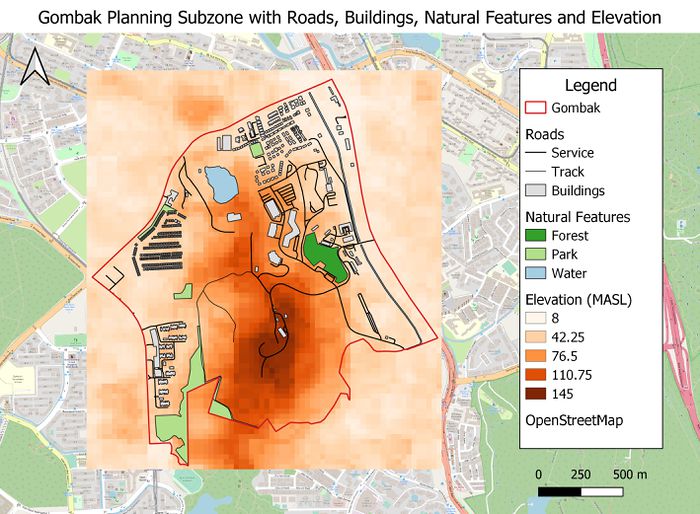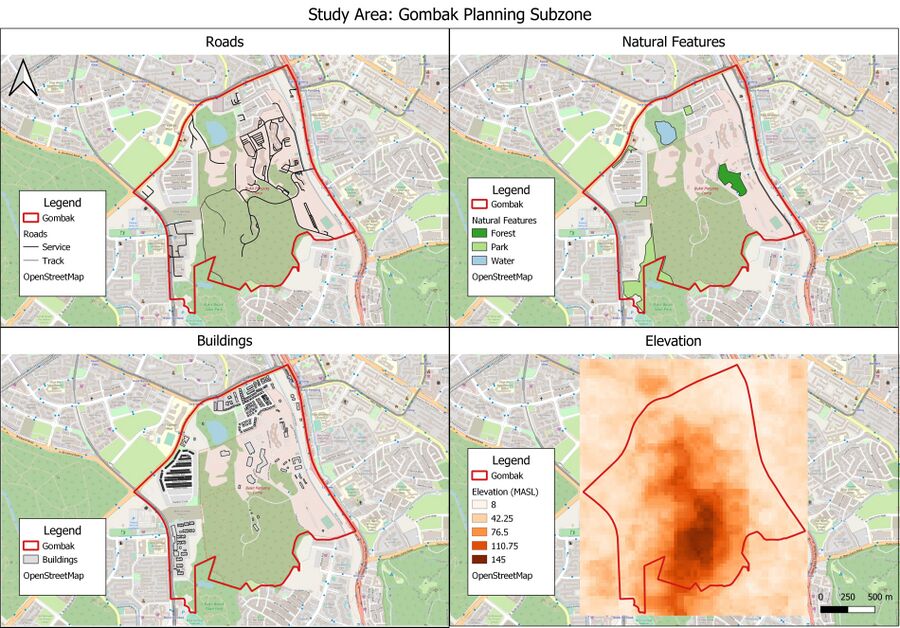SMT201 AY2019-20T1 EX2 Chong Yun Yu
Contents
Building a National Communicable Disease Quarantine Centre
To identify a location suitable for building a National Communicable Disease Quarantine Centre, there is a need to first look at the points of interests in Gombak planning subzone. Four decision factors that are particularly relevant have been identified:
- Accessibility factor: proximity to local roads, such as service roads and tracks
- Health risk factor: proximity to population, in particular proximity to buildings
- Natural conservation factor: proximity to natural features, such as parks, forests, and water bodies
- Economic factor: elevation/steepness of slope
These factors will be discussed in more detail below.
Data Source: Master Plan 2014 Subzone Boundary (No Sea) (SHP) from URA.[1]. Roads, Buildings and Natural (SHP) from OpenStreetMap.[2]. ASTER Global Digital Elevation Model (GDEM) dataset (TIFF) jointly prepared by NASA and METI, Japan; raster dataset combined by Professor Kam Tin Seong.[3].
Data Source: Master Plan 2014 Subzone Boundary (No Sea) (SHP) from URA.[4]. Roads, Buildings and Natural (SHP) from OpenStreetMap.[5]. ASTER Global Digital Elevation Model (GDEM) dataset (TIFF) jointly prepared by NASA and METI, Japan; raster dataset combined by Professor Kam Tin Seong.[6].
Accessibility Factor (Roads)
The selected site should be close to local roads to ensure easy transportation of building materials during the construction stage. The roads are shown in a line vector, and are categorized into service roads, which are shown using thicker strokes; and tracks, which are shown using thinner strokes. There are 199 service roads and only 2 tracks. The service roads spread across most of the Gombak planning subzone, and are mostly concentrated in the North-East region, whereas the 2 tracks are located at the South and central region of Gombak.
Health Risk Factor (Buildings)
The selected site should be away from population to prevent the diseases from spreading to the public. Seven types of buildings have been identified from the data provided from OpenStreetMap, they include clinic, construction site, garage, place of worship, public space, residential area, and train station. However, out of the 527 buildings identified in Gombak, 505 buildings are of "unknown" type in the data provided. Hence, it would not be meaningful to categorize the buildings based on their type. All buildings are treated as population indicators, and the selected site should be away from the buildings.
Natural Conservation Factor (Natural Features)
The selected site should be also be away from natural features, such as forests, parks and water bodies. There are 1 forest, 4 parks and 3 water bodies identified. All of these natural features are located near the peripherals of the Gombak planning subzone. The forest is depicted with dark green on the map, while the parks and the water bodies are depicted using light green and light blue respectively.
Economic Factor (Elevation)
text
Proximity Analysis on the Four Decision Factors
(insert file)
Data Source: Master Plan 2014 Subzone Boundary (No Sea) (SHP) from URA.[7]. Roads, Buildings and Natural (SHP) from OpenStreetMap.[8]. ASTER Global Digital Elevation Model (GDEM) dataset (TIFF) jointly prepared by NASA and METI, Japan; raster dataset combined by Professor Kam Tin Seong.[9].
text
Proximity to Roads
text
Proximity to Buildings
text
Proximity to Nature
text
Slope
text
Criterion Scores on the Four Decision Factors
(insert file)
Data Source: Master Plan 2014 Subzone Boundary (No Sea) (SHP) from URA.[10]. Roads, Buildings and Natural (SHP) from OpenStreetMap.[11]. ASTER Global Digital Elevation Model (GDEM) dataset (TIFF) jointly prepared by NASA and METI, Japan; raster dataset combined by Professor Kam Tin Seong.[12].
text
Analytical Hierarchical Process Input Matrix and Result Report
(insert file)
Data Source: AHP Template from SCBUK (XLS).[13]
text
Suitable Land Lots Identified
(insert file)
Data Source:
text

